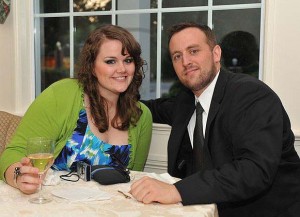The first wedding Jenna and Michael photographed was for a friend who didn’t have a budget for photography. Both were interested in photography as a hobby and maybe it was inevitable that they would turn wedding photography into a business: Michael Beard Photography. They are based in Delaware, but ready to travel the East Coast and beyond.
 Jenna works closely with the brides to make sure all the important moments of the day are captured. That’s the being at the right place at the right time portion. Michael is the techie who knows exactly how capture the right moment in all its glory for posterity.
Jenna works closely with the brides to make sure all the important moments of the day are captured. That’s the being at the right place at the right time portion. Michael is the techie who knows exactly how capture the right moment in all its glory for posterity.
That combination of social connection and technical perfection gives Jenna and Michael their edge. “We feel that everybody and their brother has a photography business these days,” Jenna says. “We thought about it for a long time — we didn’t want to be known as your everything photographer. We wanted to be known for a few key areas. We focus on wedding and family photography.” Jenna stresses that she and her husband want to be amazing at a few things instead of okay at a lot of things.
Weddings and family photography are an art. As Jenna puts it: “You have to capture that first kiss and if you miss it, you’ve failed.” There will be other kisses at the wedding, but not that first kiss! And that’s just one of many unique moments. “Every wedding is different and we love it. It’s a challenge.”
Jenna and Michael started out by doing their homework. They researched other wedding photographers in the area. They connected with photographers online, built relationships, and learned from what worked in their businesses. That helped them set pricing lists and cover legal details.
Yet in all the research and planning, they didn’t forget their clients. Says Jenna: “We look at this from the perspective of a bride and groom. When we got married we had to hire a photographer. Even now we connect with our clients because we’ve been through the same thing.”
Weddings typically happen on weekends and there are only so many weekends in a year. So while a hard-working commercial photographer can do client shoots 5 days a week, a wedding photographer may only do one shoot in a week.
That has colored Jenna and Michael’s approach to starting their business. They both work full-time in other jobs, allowing them to grow the business from of its revenue and let it find itself in the process.
From a client perspective, a wedding only seems to involve a few hours at the ceremony and reception. Michael says they learned that’s not so: “The biggest mistake that we made was our pricing. We came at that a little too low.” They needed to factor in all of the time that really went into the process before, during, and after the event: meeting with prospective clients, planning the shoot, pulling gear together, travel time, processing images and delivering proofs and images to clients. Pricing ultimately has to reflect all that.
Says Michael: “You think you’re making a lot of money from the wedding, but you’re really not. — We had to look at what do I want to make an hour.” As a result, their lowest priced package went from $1500 to $2300.
This dynamic duo has photographed 16 weddings so far in 2013. In between, they schedule photo sessions with families or engaged couples on a case-by-case basis. The next goal is for Jenna to go full-time in the business, with Michael joining her eventually.
Along the way, they are refining their style and seek to work with clients who fit that style. That’s a win-win. Clients are satisfied and it allows Jenna and Michael to be successful. Jenna explains: “The biggest thing we focus on is that our clients are a good fit for the way that we shoot. I just don’t want someone to hire us because we’re in their budget or we’re close by. I want people to hire us because they like our style and the way that we capture things. It’s the only way it works, because if they try to change who we are and how we shoot just because they see something on Pinterest that they like and they would rather have that picture than what we would take, that’s not a good fit for us. That probably sounds terrible, but we have them in mind. We want to be sure they are happy with what we give to them.”
Running a business takes a wide variety of skills. When you are a team, you have to figure out who will be responsible for what parts. “Our strengths work together really well. What I do with the business is mostly the business end of it,” says Jenna. “I do all of our client interaction, emails, paperwork, contracts, finances and bookkeeping, marketing — all of that back end stuff is mostly my responsibility. That happened just naturally. That was what I was good at and I knew that kind of work. It wasn’t like: Okay, you do this, this, and this. It just kind of happened.”
The technical side of the business is handled by Michael who has experience in IT and is constantly researching new processes and techniques for them to use. “He’s so patient with research where I have zero patience for research. He’ll spend hours researching is this lens better than this lens? He’ll buy and trade gear on the forums. He does all that good stuff.”
Dividing up responsibilities in the business is vital, but not everything. Jenna continues: “The biggest thing was learning we need to have time for each other: we’re not roommates, we’re a married couple.” Even with the pressure of starting up a business and each working a full-time day job, or maybe because of it, they have learned to set some boundaries: They set aside three days a week to work on the business and then use some of the other days to focus on their personal lives — all to keep a balance and not lose their creativity in the process of building a business.
Jenna and Michael have figured out what each of them is good at and gets excited about in the business and divided their functions based on that. If you are in a partnership or working with someone else in your business, how do you decide who does what? Is everyone able to work using their strengths?
Starting a business is inherently risky. For Jenna and Michael, a way to lessen the risk is to grow the business as it generates the funds needed, while they continue to work other jobs. How do you evaluate risks with starting or expanding your business? What steps are you taking to minimize risks?
When starting a business, we are often excited about our product or service. But are the prospective clients equally excited? Jenna and Michael found ways to relate to couples getting married through shared experiences. What can you do to better connect with your clients and see their perspective?
Read part 2 of the Beard's story here.
This post is part of the series Small Business Success Stories! Read more here.
Claes Jonasson is the owner and founder of Film & Company, LLC. He likes to draw and write fiction when he can grab a few minutes between media and design projects.
Stephanie Jonasson is a writer for Film & Company, LLC. When she is not helping small businesses define their brand, she enjoys curling up with a cup of tea and a good book.



 Take the Assessment
Take the Assessment



{ 2 comments… read them below or add one }